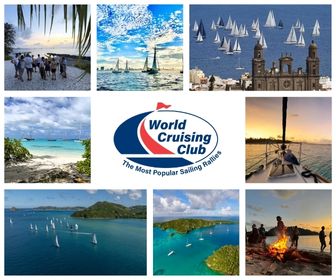Guinea Bissau, Bijagos Archipelago: An Unknown Paradise
Why rush to cross the Atlantic for the Caribbean, say Knut Kähler and Bianka Martens of SV Habiby, when there is so much to see on the eastern side? Having sailed from the Canaries to Cape Verdes, they spent time exploring West Africa. After Senegal and Gambia, the highlight was Guinea Bissau – a former Portuguese colony – that they say, despite the tricky navigation, was an “unknown paradise”.
Published 2 months ago
Guinea Bissau – A Blend of African, Portuguese and Island Influences
Guinea-Bissau, a small West African nation nestled along the Atlantic coast between Senegal and Guinea, offers an unspoiled and intriguing destination for adventurous sailors. Covering around 36,000 square kilometres – roughly the size of Switzerland – this former Portuguese colony is best known for its scattered Bijagós Archipelago, a UNESCO Biosphere Reserve of over 80 islands teeming with wildlife and rich cultural traditions. The mainland and islands alike are characterized by mangrove-lined estuaries, low-lying forests, and remote fishing villages.
Despite its natural wealth, Guinea-Bissau remains one of the world’s poorer countries, with a fragile economy largely dependent on agriculture, fishing, and cashew exports. Its history is marked by Portuguese rule until independence in 1974 and a series of political upheavals that have left the nation somewhat isolated, yet remarkably authentic.
Knut Kähler and Bianka Martens of SV Habiby, report on their time cruising in Guinea-Bissau in October/November 2024 – which they visited after exploring Senegal and The Gambia – prior to crossing the Atlantic.
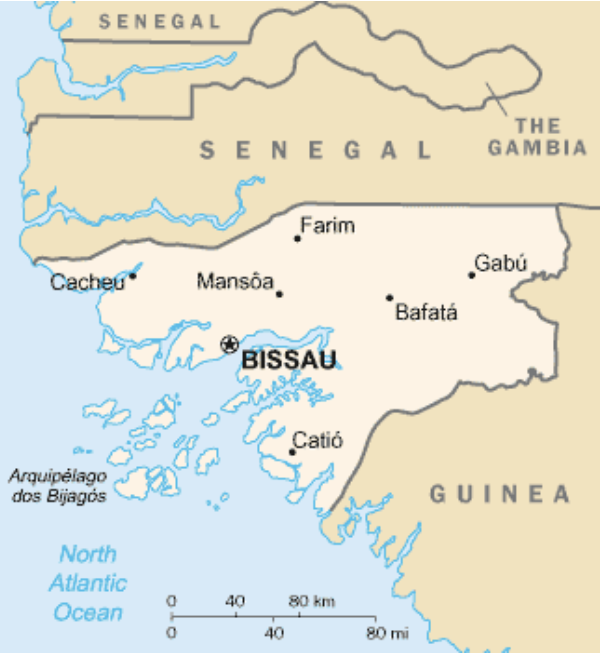

The Bijagos Archipelago
The Bijagos Archipelago consists of 88 islands, of which only 20 are inhabited and stretches over 13000 km². It has been declared a National Park and since 1996 also a UNESCO Biosphere Reservation. The islands are covered with thick secondary forest, there are lots of white sandy beaches and the flora and fauna is amazing.
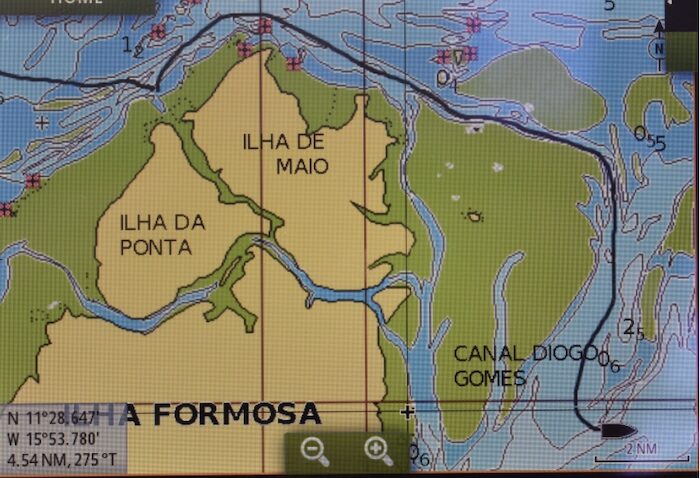

A Paradise
Even hippopotamus and saltwater crocodiles can be seen. Great to see also, that the waters are full of fish, due to the fact that they are shallow enough to prevent commercial trawlers from fishing here. The absence of bigger international tourism is another advantage. During all the weeks we did not see a single other yacht. There are a few lodges and fishing camps with mainly tourists from Portugal or Bissau, who often come for fishing and sun bathing.


Nice Check-in at Porto Bubaque
Yachts can clear in Cacheu, Bissau or Porto Bubaque on the island of Bubaque. We were told that Bissau is not ideal, because the officials are apparently not welcoming at all and make life difficult for the sailor. Also it is difficult to anchor there. It is situated at the Rio Ceba, whereas Porto Bubaque is directly on the island Bubaque in the Bijagos Archipelago. Here we had the nicest check in ever. After anchoring at the harbor with strong tide, a boat approached and the harbor master came alongside and politely asked permission to come on board. He even invited to take us over for the necessary procedures.
For Guinea Bissau, besides the normal papers you will need a Visa, which we got without a problem in one hours’ time at the Embassy of Guinea Bissau in Banjul, Gambia.
It is important to fly the National flag of Guinea Bissau above the yellow flag Q. Otherwise you risk a fine. You need to see the harbor master, immigration, customs, national park agency and police, but they will all get together for you in a little hut and the harbor master will write your cruising permit on an ancient type writer. It cost us 150 Euro. For us the check – in was done after one hour and we were brought back to our yacht.
Practicalities
The currency is called West African Franc (CFA). There is no ATM on the islands, so it is mandatory to have enough cash with you for the time you are around. You cannot pay with credit cards in the little shops either.
There is no public garbage disposal, a problem we had to face and solved by burning it by ourselves on the beaches and afterwards digging the ashes deep into the ground.
The provisioning proved to be difficult with very little fresh products in the market and also not a great variety of conserved food. We were glad to have stocked up on everything we needed, including for the crossing of the Atlantic, previously in Banjul/Gambia. We could get some tomatoes, potatoes and eggs. But some of them were already incubated.
Tides, Currents and Depths
Springtide will have a difference up to five metres! This will create a strong current. The whole area is flat and resembles the Wadden Sea in the North Sea. Large areas dry out at low water. You will not be able to navigate properly by Navionics maps, as often tidal creeks are not mentioned or the depths are not correct where they are mentioned. Worst of all there are no navigation marks whatsoever, which makes navigation difficult.
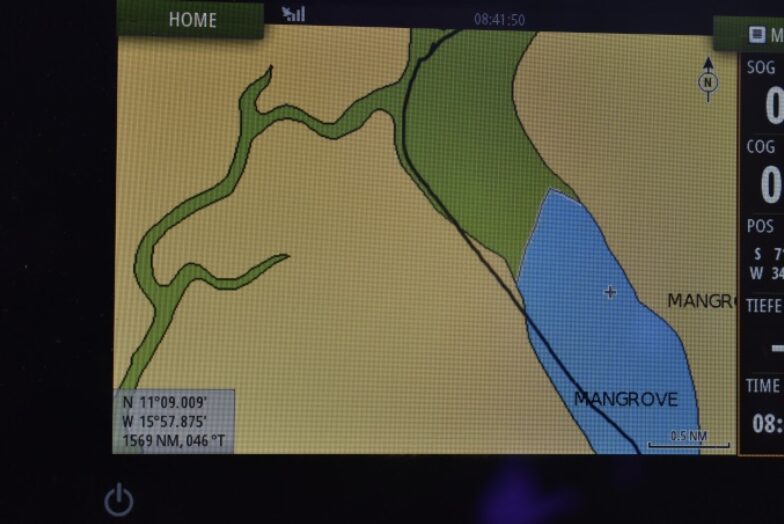

We found it easiest to look at the whole area and creeks at low tide to remember the fairways and then follow those when the tides are still rising, so you have a chance to get free, when you touch the ground. The echo sounder is the most important instrument now to find the deepest part of the creeks. As it never becomes flat abruptly, you can stop as soon as you only have 40-50 cm below the keel and test yourself slowly forward into deeper waters from there.


Wherever there is a junction, most likely you will have a bar. As there is no waves to speak of, we managed with 2.10 m draft to get through everywhere without too much touching of the ground. Large areas dry up at low tide and the currents are 3 to 4 knots.
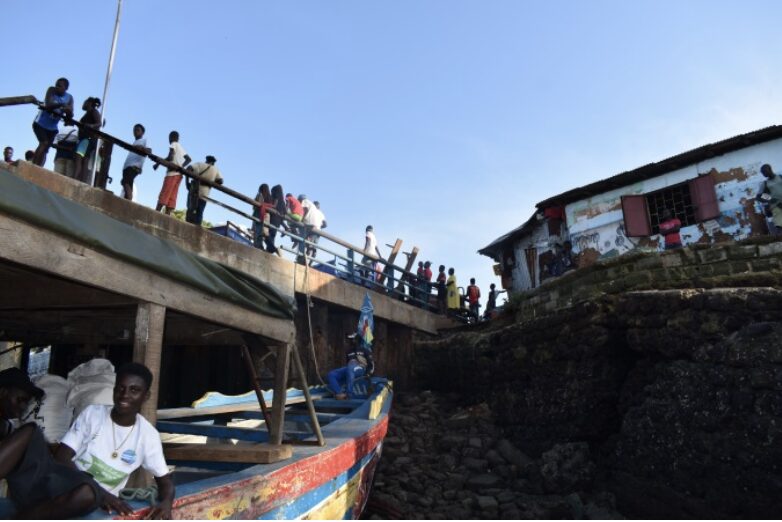

Weather
Rainy season is from June to October and the dry season from December to April. Most of the time it is hot! We had 30-35degree Celsius, high humidity and little wind most of the time, having been around from beginning of October to beginning of November.
During the day it was always a blue sky, whereas in the evenings one can see big dark clouds mounting up above the mainland, drifting towards the islands. Hence, at around 2 a.m. at night we very often had to endure severe squalls, with winds between 20 and 30 knots (once even 50 knots) and heavy rains.
Anchoring
The ground for anchoring consists of sand and clay, so with our 52 kg bow anchor and 13mm chain, we never slipped.
We did, however, have to dismantle the bimini/awning every evening for these 30-minute squall events – we learned this the hard way! During the day the awning is an absolute necessity.
Next time we would not sail into this beautiful area before mid-November.
There is basically no crime, people have been very kind, so why rush to the Caribbean if there are more beautiful islands on the east side of the Atlantic? Although you need to motor a lot, as there is often not enough wind for proper sailing.
Knut Kähler and Bianka Martens
SV Habiby
…………………………………
Related Reports:
The Gambia: An Unforgettable and Amazing Country [2024]
West Africa, Guinea Bisseau: An Unexplored Paradise [2021]
…………………………………
© 2025 Noonsite. This content was edited by Noonsite. Do not reproduce without permission. All rights reserved.
The opinions expressed in this article are the author’s own and do not reflect the view of Noonsite.com or World Cruising Club.
If you have found this information useful, become a paid member to enjoy unlimited use of Noonsite plus many other perks. Your membership fees really help our small, dedicated team keep country information up-to-date in support of cruisers worldwide. Find out more about Noonsite Membership levels and benefits here.
Subscribe to our FREE monthly newsletter.
Related to following destinations: Bissau, Bolama, Bubaque, Cacheu, Guinea-Bissau
Related to the following Cruising Resources: Atlantic Crossing, Atlantic Ocean East, Circumnavigation, Cruising Information, Routing, World Regions Information




